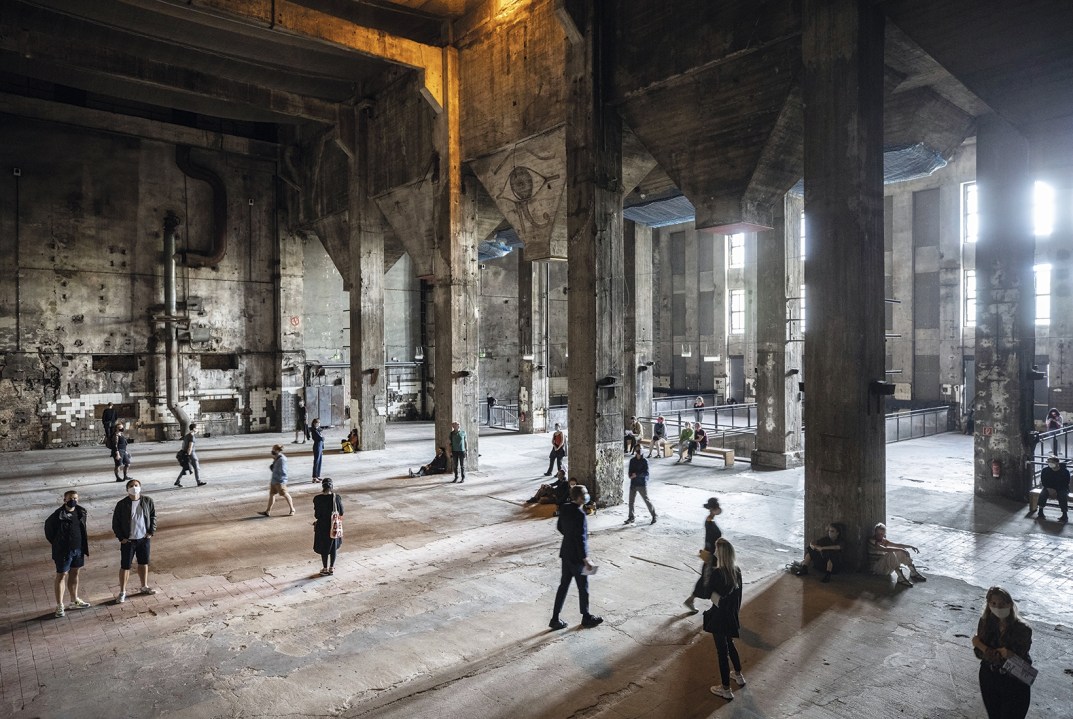In Geoff Dyer’s Jeff in Venice, the protagonist, at the Venice Biennale, muses on installations. ‘Ideally, the perfect art installation would be a nightclub, full of people, pumping music, lights, smoke machine and maybe drugs thrown in. You could call it Nightclub, and if you kept it going 24 hours a day it would be the big hit of the Biennale.’ How right he was. For what else is Berghain — the world’s most famous techno club — if not a wild work of immersive art?
Berghain is housed in the ruin of a Soviet thermal power station in Berlin. Conceived on a grand scale, it’s a fathomless black box you enter into for 12 or so hours to be pummelled by every sort of sensation, before stumbling out again, not quite sure what happened. As immersive art goes, from Tino Sehgal to IMAX, there really isn’t much to compete with it.
What else is Berghain – the world’s most famous techno club – if not a wild work of immersive art?
Berghain’s founders cut their teeth organising hardcore gay fetish nights. In 2004, the city authorities offered them the ex-GDR building. In 2016, Berghain was granted the same generous tax status as the city’s high art institutions. Recent management changes have seen Berghain further inch towards corporate respectability. In 2018, a Damir Doma fashion show was held there, arranged by Vogue Germany boss Christiane Arp and owner Norbert Thormann. Inevitably, a tension has emerged between subcultural vitality and corporate ambition, and it plays out in the art exhibition currently showing there.
Studio Berlin, which opened during Berlin Art Week, saw Berghain invite the general public inside for the first time (except for the men-only space Lab.Oratory). Organised in partnership with the Boros Foundation, the show invited 115 Berlin-based artists to submit a work for display in Berghain reflecting the lockdown and being bound to one’s studio. Some stick to this brief, others thankfully ignore it. The result is a hodgepodge with little continuity.
Rirkrit Tiravanija has swaddled Berghain’s outer façade with a banner saying ‘TOMORROW IS THE QUESTION’. It looks like a plaster on the building’s concussed forehead (thank you, 2020). Inside, on a plinth at the bottom of the main staircase where there used to be a statue of a frenzied naked man holding a cornucopia, there is now a cute sculpture of a PA speaker. Unfortunately, our tour guide was harrying us at breakneck speed, so I didn’t have time to get the artist’s name.
By the main-room dancefloor, Jimmy Robert shows cross-section images of black bodies dancing. An inflatable buoy bobs in the air (Julius von Bismarck’s gimmicky ‘Die Mimik der Tethys’), modelling the movement of a buoy in the Atlantic. Over the DJ box, Khaled Barakeh’s Dali-esque ‘One Hour is Sixty Minutes and Vice Versa’ is a huge clock whose hands spin backwards, feeding the surreal atmosphere. Where the club’s darkrooms usually are, Dirk Bell has created a bright installation featuring erotic pencil drawings. Collectively, it’s like a joint commentary on what usually goes on here.
Afterwards, things get diffuse. The issue — which curators Juliet Kothe and Karen Boros should have anticipated —is that, regardless of the artwork, it tends to be swamped by the venue’s charismatic immensity. As Dyer noted, this club space already has a strong identity as an artwork. Why not incorporate that? Staging an exhibition about solitude and introversion in a nightclub, of all places, seems fundamentally wrongheaded.
Some do embrace the venue. Techno producer Sam Barker has set up a Nancarrowesque self-playing piano whose notes reverberate eerily. Cyprien Gaillard’s ‘The Land of Cockaigne’ (geddit?) is a scratched engraving on a toilet cubicle’s stainless-steel wall, showing three male bodies in narcotic collapse. The engraving recalls Brassaï’s ‘Du mur des cavernes au mur d’usine’ (‘From cavern walls to factory walls’), where post-industrial graffiti was paralleled with pre-historic cave paintings.
There are big hitters — a maudlin Wolfgang Tillmans film, for example, the usual skinny naked white men and greasy-spoon breakfasts — but where is the experimentalism? Was Stonewall not a riot? The radical is mostly avoided in favour of the safe, downtown for uptown. My favourite work was Richard Kennedy’s fauvistically garish painting ‘Sandra’. A riot of abstract colour, it is crudely scrawled with graffiti-like phrases: ‘black trans lives matter — refund the street — community watch’. Raw, youthful and unmannered, it’s relegated tellingly to a space by the exit, like an afterthought.







Comments